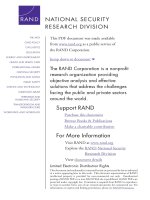A History of Governmentally Coerced Sterilization The Plight of the Native American Woman By Michael Sullivan DeFine
Bạn đang xem bản rút gọn của tài liệu. Xem và tải ngay bản đầy đủ của tài liệu tại đây (127.47 KB, 11 trang )
A History of Governmentally Coerced Sterilization: The Plight o...
/>
[back] Navajo Nation
A History of Governmentally Coerced Sterilization: The Plight
of the Native American Woman
By Michael Sullivan DeFine
May 1, 1997
By Michael Sullivan DeFine
University of Maine School of Law
Footnotes appear at the end of the text
I. Introduction
The purpose of this article is to trace the historical influence of governmentally funded sterilization
from the beginning of the eugenics movement in the 19th century to see how this effects Native
American women today. This topic will investigate the social prejudices and rationalizations for
sterilization of the "less-talented" members of society advocated by the most influential social and
biological scientists in American history.
These "science"-based eugenic influences break through the lines of science into the world of politics,
promulgating anti-humanistic views of poor women of color in the form of legislation fraught with
bigotry and baseless generalizations. This political view flows through the judicial system, as courts
apply eugenic philosophies in determining who should be sterilized and for what reasons.
Turning specifically to the sterilization of Native American women, this article concludes with a
discussion of the federal relationship with American Indian tribes, personal accounts from Native
American women who were sterilized and their attitudes toward family planning, state and federal
policies regarding informed consent and sterilization, an examination of the contractual relationship
between the Indian Health Service and private practices, the United States General Accounting Office
investigation of Indian Health Service sterilization procedures, and the meaning behind the statistics
of population growth.
II. History of Eugenics
A. Pre-Eugenic Thinking
In the early 19th century, before Darwinism entered the lexicon of science, racist as well as sexist
attitudes led scientists to become preoccupied with ranking human beings according to purportedly
neutral scientific criteria. (1) Some believed in monogenism, a notion that all humans descended from
the common ancestor Eve, but that the races degenerated in various degrees from an original state of
perfection. (2) This theory, therefore, assumed that the white race had degenerated the least, and
people of color were developmentally further away from the original divine plan.
Anthropometry (skull measuring) was also a serious scientific endeavor. The physician Samuel
1 of 11
7/31/13 9:55 PM
A History of Governmentally Coerced Sterilization: The Plight o...
/>
George Morton gathered more than 1,000 skulls to prove that intelligence is related to brain size and
that there are innate racial differences in mental capacities. (3) Morton's studies on the sizing of
human skulls were used throughout the 19th century as scientific proof of a racial hierarchy in
intelligence. (4) After the Civil War, scientists were still engaged in anthropometry. In 1870, Dr.
Sanford B. Hunt claimed that the average African American brain weighs five ounces less than the
average white individual's brain, and the average mulatto's brain is smaller than the brain of an
average African American. (5) From this, Hunt concluded intermarriage between the races would
produce inferior offspring. (6) His studies played a role in justifying the need for segregated school
systems. (7)
As Darwinism began to entrench itself into popular scientific thought, it brought with it distinct racist
and sexist overtones. The writings of E.D. Cope popularized what was known as recapitulation, the
notion that modern human beings pass through a succession of evolutionary stages, repeating the
progression of the species. (8) Cope identified four groups that displayed characteristics evidencing
lower evolutionary status: the non-white races, all women, southern European whites (Jewish people
and Italians included), and the lower classes within the superior races (Cope was particularly
contemptuous of "the lower classes of the Irish"). (9) The adults of inferior groups were considered
throwbacks who remained in an arrested evolutionary stage, more like the children of superior white
males. (10) Women's essential nature was characterized as similar to what men exhibit at a younger
age. America's premier psychologist, G. Stanley Hall, interpreted the higher suicide rate in women as
a sign of their stunted evolutionary development. (11)
B. The Early Eugenics Movement
The pre-eugenics evolutionary theories noted above germinated the seeds of the eugenics movement.
The term eugenics, which means literally "wellborn", originated in 1883 with Sir Francis Galton, a
cousin of Charles Darwin. (12) Galton advocated the scientific regulation of human breeding to ensure
the more talented (primarily those of the upper-class and the industrious members of the middle-class)
have a better chance of predominating in the propagation of the species. (13) By the 1920's, when
eugenics became a required course in many universities, (14) a typical textbook published by BobbsMerrill stated:
For our own protection we must face the question of what types of races should be ruled
out… many students of heredity feel that there is great hazard in the mongrelizing of
distinctly unrelated races… However, it is certain that under existing social conditions in
our own country only the most worthless and vicious of the white race will tend in any
considerable way to mate with the negro and the result cannot but mean deterioration on
the whole for either race. (15)
This academic agenda of fear found its way into the political ranks when Congress passed the
Immigration Act of 1924, which limited immigration to two percent of those of the same national
origin that lived in the United States in 1890. (16) This Act was passed by Congress in large measure
because of information supplied by the intelligentsia of the eugenics movement, namely Carl
Brigham. He interpreted army data on immigrant intelligence and concluded that as the proportion of
those with "superior" Nordic blood decreased, and "inferior" Alpine and Mediterranean blood
increased, the intelligence of the immigrants declined. (17) Other "scientific" studies characterized the
2 of 11
7/31/13 9:55 PM
A History of Governmentally Coerced Sterilization: The Plight o...
/>
inferior races as "human parasites"(18) and "filthy, un-American and often dangerous in their habits".
(19)
The eugenics movement promoted the elimination of so-called inferior immigrants from entering the
United States and spreading their inferiority "upon the stock of the nation". (20) The primary goal of
the movement, however, was to promote the sterilization of the "unfit". With success in influencing
Congress established, Harry Laughlin, a eugenics movement supporter, drafted a model eugenics
sterilization law that was adopted in various versions by many states in this country. (21) The laws
were typically aimed at epileptics, the mentally impaired, alcoholics, drug addicts, and criminals. (22)
Approximately 50,000 sterilizations were performed in the United States by the end of World War II.
(23) This number pales in comparison, however, with the number of women sterilized in more recent
years. (24)
C. Eugenics in the Modern Age
Since the 1970's, sterilization has become the most common form of birth control for women over the
age of twenty-five in the United States. (25) Between 1970 and 1980, sterilization rates tripled, and in
1987, twenty-four percent of the entire population of women of childbearing age were sterilized. Part
of this increase in surgical procedure is due to the liberalization of indications for sterilization
recommended by the American College of Obstetricians and Gynecologists. (26) More significantly,
as in the past, societal prejudices and a class-based racist ideology determine the selection process,
although on the surface women voluntarily consent to the procedure. (27) Sterilization might not be
the choice of many women if they were better informed and able to receive higher quality medical
care.
As of 1982, fifteen percent of white women had been sterilized, compared with twenty-four percent of
African-American women, thirty-five percent of Puerto Rican women, and forty-two percent of
Native American women. (28) In the early 1970's, an estimated 100,000 to 150,000 low-income
individuals were annually subjected to sterilization under federally funded programs. (29)
Turning now to the resultant effects on Native American women, a class traditionally oppressed by
economic, social, and financial hardship, one can see just how influential the philosophies of the
eugenics movement have been in recent years.
III. Native American Sterilization, 1972-1976
A. The Federal Relationship with American Indian Tribes
The federal trust relationship with American Indian tribes is based on numerous treaty rights and
agreements that include availability of medical services and physicians for Indians. However, there
are very few statements that mention medical services specifically; instead there is an implicit
understanding of the trust responsibility that includes the health of the American Indians. (30) As
stated in the American Indian Policy Review Commission's report on Indian health, " the federal
responsibility to provide health services to Indians has its roots in the unique moral, historical, and
treaty obligations of the federal government, no court has ever ruled on the precise nature of that legal
basis nor defined the specific legal rights for Indians created by those obligations." (31) The implied
3 of 11
7/31/13 9:55 PM
A History of Governmentally Coerced Sterilization: The Plight o...
/>
meaning of health care responsibilities is somewhat vague, but the treaties and agreements were
supposedly intended to favor Indians.
In 1955, The Indian Health Service was transferred from the Bureau of Indian Affairs to the Public
Health Service. (32) This move was made with the expectation that the Public Health Service could
improve health care for Indians living on reservations. (33) Even after the transfer took place,
however, the health needs for Indians were still not adequately met. (34) This was due to the
ambiguous nature of the federal government's responsibility to provide health care. (35) In turn, the
Indian Health Service had no concrete goals or objectives and operated day to day with only a faint
clue as how it should render services. (36)
Even today, an Indian client will be given services that may well vary each time that patient enters an
Indian Health Service facility. "The specific services available to [the patient] will vary from day to
day and year to year, depending on unpublished discretionary decisions made by Indian Health
Service officials and commitments and conditions contained in often voluminous appropriation
hearings." (37) This quote suggests that the Indian Health Service system is ripe for mismanagement
of policies, funding, and staff supervision. (38) It also comes as no surprise to find that the Indian
Health Service has been the subject of a number of investigations. (39)
B. Personal Accounts from Sterilized Native American Women and Their Attitude Toward
Family Planning
One of the people who initiated the government investigation into the Indian Health Service's
sterilization policy was Dr. Connie Uri, a Choctaw Indian Physician working at the Claremore,
Oklahoma Indian Health Service facility. (40) Dr. Uri noticed in the hospital records that a large
number of sterilization surgeries had been performed. This prompted her to conduct her own
interviews with the women involved and she found that many had received the operation only a day or
two after childbirth. (41) In the month of July, 1974 alone there were forty-eight sterilizations
performed and several hundred had been conducted in the previous two years. (42) The hospital
records showed that both tubal ligation and hysterectomies were used in sterilization. Dr. Uri
commented that "in normal medical practice, hysterectomies are rare in women of child bearing age
unless there is cancer or other medical problems". (43)
Besides the questionable surgery techniques taking place, there was also the charge of harassment in
obtaining consent forms. (44) In an incident of harassment at the Claremore facility, one woman was
told by social workers and other hospital personnel that she was a bad mother, and they threatened to
place her children in foster homes if she would not agree to the surgery. (45)
In one study conducted on the Navajo Reservation and sponsored by the Public Health Service,
researchers reported:
From 1972 to 1978 we observe a 130 per cent increase in the number of induced
abortions performed. During this time the ratio of abortions per 1,000 deliveries has
increased from approximately 34 to 77 (an increase of 126 per cent). (46) While not
exactly within the confines of sterilization, the numbers indicate that the family planning
program on the Navajo Reservation was definitely acquiring federal funds to carry on
4 of 11
7/31/13 9:55 PM
A History of Governmentally Coerced Sterilization: The Plight o...
/>
such a massive project. (47)
The statistics concerning Navajo sterilization were also addressed by a Public Health Service
sponsored study, which found that "between 1972 and 1978, the percentage of interval sterilization
has more than doubled from 15.1 per cent in 1972 to 30.7 per cent in 1978." (48)
Although the report itself was conducted in a clinical and methodical manner, the researchers did
comment slightly about the relationship between patient and physician, stating that "[o]lder women
who become pregnant may be much less concerned about reducing their childbearing and may do so
primarily when they are influenced by health care providers." (49) In light of previously mentioned
tactics promoting the sterilization of Native American women, one can only speculate regarding the
nature of the "advice" or "influence" provided by these health care providers.
Once the word of sterilization spread throughout Indian Country, some tribal leaders carried on their
own investigations. Marie Sanchez, a tribal judge of the Northern Cheyenne Reservation, interviewed
fifty women, twenty-six of whom reported that they were sterilized. (50) One doctor told several
women that they each had enough children and it was time they stopped having children. (51) Others
were even told that they could have children after the operation. (52)
The attitudes of some members of the health care profession regarding the appropriateness of the
number of children these Native American women "should" bear underlines the differing value
structure between "white" America and Native American culture. The idea of such population control
measures leaves many Native Americans understandably concerned. They believe that the federal
government has done enough throughout history to limit the number of Indians living on this
continent, and the idea of limiting the number of Indian children is based on what whites feel is an
appropriate amount. (53)
Other researchers have found these general feelings to be true, regarding the limitation of Indian
family members. One group of researchers gathered data on urban and rural Omaha Indians in
Nebraska to determine if either group had different opinions on family planning. The team found that
"the family economic situation, the ability to care for the children now and later, family happiness,
and the feeling that the couple had enough children were valid considerations in a decision to delay or
prevent further pregnancies." (54) The team also noted that the "freedom for the mother to work, and
the belief that a small population was good for the country, were generally not sufficient cause [for
birth control]." (55)
C. State and Federal Policies Regarding Informed Consent and Sterilization
Dr. Louis Hellman, the Deputy Assistant Secretary for Population Affairs in the Public Health
Service, presented statistics confirming that 150,000 low income people were sterilized in the United
States by means of federal grant money. (56) These funds allowed the states to be reimbursed for up
to 90 percent of the cost of sterilizing indigent women. A report from the Department of Health,
Education, and Welfare stated:
Voluntary sterilization is legal in all states. Although most states have no statute
regulating voluntary sterilization, over half authorize the procedure either explicitly by
5 of 11
7/31/13 9:55 PM
A History of Governmentally Coerced Sterilization: The Plight o...
/>
statute, attorney general's opinion, judicial decision, or policies of [the] Health and
Welfare department or implicitly through consent requirements . . . . (57)
Since the states themselves are not following any set policies, it would be reasonable to assume that
the Indian Health Service does not either. Thus, there is a valid suspicion regarding the effective
management of resources and people at the Indian Health Service.
D. An Examination of the Contractual Relationship Between the Indian Health Service and
Private Practices
Researchers on the Navajo Reservation observed that the trend toward increased female sterilizations
had to do with the health care providers, who were found to be responsible for the huge increase
(almost 300% since 1970) (58) of patients "agreeing" to surgery. The team further stated that the
pattern of childbearing on the Navajo Reservation was very similar to those in developing countries.
(59) The following statement further illustrates the paternalistic and authoritative attitude that many
physicians have toward women: "persons in the lower educational classes rely more on such
operations [hysterectomies]; they have been least likely to control their fertility in other ways, and
doctors may finally suggest this method." (60)
Contract Care entails formal agreements with private vendors and is used when the Indian Health
Service cannot equip its staff or facilities for emergency or specialty care or if there is an overload of
patients. (61) Contract physicians associated with the Indian Health Service are reimbursed for each
sterilization. (62) The reimbursements that the physicians receive come from federal funds, but are
not federally accountable: "thirty percent of the sterilizations were performed at 'contract' facilities.
[Indian Health Service] officials in the Albuquerque and Aberdeen areas said they do not monitor the
consent procedures in contract care, nor are doctors required to follow federal regulations." (63)
Normally, agencies which receive funding from the federal government must follow federal
guidelines. The Indian Health Service, however, shows a lack of concern and accountability with the
patients they treat and the money they handle. (64)
E. The United States General Accounting Office Investigation of the Indian Health Service
Sterilization Procedures and the Meaning Behind Statistics of Population Growth
Complaints of these unethical sterilization practices continued, but little was done until the matter was
brought to the attention of Senator James Abourezk (D-SD). Finally, affirmative steps were taken specifically the commissioning of the General Accounting Office - to investigate the affair and to
determine if the complaints of Indian women were true - that they were undergoing sterilization as a
means of birth control, without consent. (65) The problem with the investigation was that it was
initially limited to only four area Indian Health Service hospitals (later twelve); therfore, the total
number of Indian women sterilized remains unknown. (66) The General Accounting Office came up
with a figure of 3,400 women who had been sterilized; but others speculate that at least that many had
been sterilized each year from 1972 through 1976. (67)
The General Accounting Office confined its investigation to Indian Health Service records and failed
to probe case histories, to observe patient-doctor relationships, or to interview women who had been
6 of 11
7/31/13 9:55 PM
A History of Governmentally Coerced Sterilization: The Plight o...
/>
sterilized. (68) This deplorable lack of thorough investigation only served as an attempt to placate the
concerns of Indian people.
The General Accounting Office investigators concluded that Indian Health Service consent procedures
lacked the basic elements of informed consent, particularly in informing a patient orally of the
advantages and disadvantages of sterilization. (69) Furthermore, the consent form had only a
summary of the oral presentation, and the form lacked the information usually located at the top of the
page notifying the patient that no federal benefits would be taken away if she did not accept
sterilization. (70) The General Accounting Office notified the Indian Health Service that it should
implement better consent procedures. Some Indian Health Service Area Directors were pressured by
local Indians and by Indian physicians and staff to suspend certain nurses and to move the hospital
administrators to another post. Other than that, however, there was little else done by government
officials. (71)
Outraged by the level of governmental inaction, Indian people accused the Indian Health Service of
making genocide a part of its policy. For the Indian Health Service, this was a serious accusation, as
the purpose of this agency was to somehow alleviate the terrible health conditions in Indian
communities. The Indian Health Service defended itself by relying on the inaccurate sterilization
figures provided by the General Accounting Office. (72) In reality, however, the accusation of
genocide was not far off base. As Thomas Littlewood stated in his book on the politics of population
control, "non-white Americans are not unaware of how the American Indian came to be called the
vanishing American . . . [t]his country's starkest example of genocide in practice." (73)
From a statistical point of view, the reality of the devastation of Native American women victimized
by sterilization can be observed through the comments of Senator Abourezk himself: "given the small
American Indian population, the 3,400 Indian sterilization figure [out of 55,000 Indian women of
childbearing age] would be compared to sterilizing 452,000 non-Indian women." (74)
IV. Conclusion
Science has provided a means of categorizing and victimizing those in society deemed unworthy of
continued existence. Its influence in academic and political circles has created a pervasive social
bigotry that rewards extermination over reform. The failure to embrace the racial and cultural
diversity of this country has left a wake of destruction and oppression in minority populations. It is
time for the pundits of social change to rearrange their thinking and give back to the people the power
to choose what is right for themelves.
Return to Main Index on Coerced Sterilization
7 of 11
7/31/13 9:55 PM
A History of Governmentally Coerced Sterilization: The Plight o...
/>
Footnotes
1 Beverly Horsburgh, Schr degreesodinger's Cat, Eugenics, and the Compulsory Sterilization of
Welfare Mothers: Deconstructing an Old/New Rhetoric and Constructing the Reproductive Right to
Natality for Low-Income Women of Color, 17 CARDOZO LAW REVIEW 536 (1996).
2 Id. at 538
3 Id. at 539
4 Id.
5 Herbert Hovenkamp, Social Science and Segregation before Brown, 1985 Duke L.J. 624,625
6 Id.
7 Id. at 630-632 (citing Berea College v. Kentucky, 211 U.S. 45 (1908) (upholding a Kentucky statute
prohibiting integrated schools)).
8 Beverly Horsburgh, Schr degreesodinger's Cat, Eugenics, and the Compulsory Sterilization of
Welfare Mothers: Deconstructing an Old/New Rhetoric and Constructing the Reproductive Right to
Natality for Low-Income Women of Color, 17 CARDOZO LAW REVIEW 536 (1996) (citing Stephen
J. Gould, The Mismeasure of Man (1981) at 114-115.
9 Id. at 115.
10 Id.
11 Id. at 118
12 Ruth Hubbard and Elijah Wald, Exploding the Gene Myth: How Genetic Information is Produced
and Manipulated by Scientists, Physicians, Employers, Insurance Companies, Educators, and Law
Enforcers (1993), at 14.
13 Beverly Horsburgh, Schr degreesodinger's Cat, Eugenics, and the Compulsory Sterilization of
Welfare Mothers: Deconstructing an Old/New Rhetoric and Constructing the Reproductive Right to
Natality for Low-Income Women of Color, 17 CARDOZO LAW REVIEW 536 (1996) (citing Francis
Galton, Hereditary Talent and Character, in Adam Miller, Professors of Hate, in The Bell Curve
Debate: History, Documents, Opinions (Russell Jacoby and Naomi Glauberman eds., 1995) at 393,
396, 406-442.
14 Linda Gordon, Woman's Body, Woman's Right: A Societal History of Birth Control in America (rev.
ed. 1990), at 276.
15 Id. at 277-278 (quoting Michael F. Guyer, Being Well-Born (1916), at 296-298).
16 The Immigration Act of 1924, ch.190, §11(a), 43 Stat. 153, 159, amended by The Immigration and
Nationality Act, ch. 477, §201, 66 Stat. 175 (1952), amended by Pub. L. No. 89-236, §1, 79 Stat. 911
8 of 11
7/31/13 9:55 PM
A History of Governmentally Coerced Sterilization: The Plight o...
/>
(1965).
17 Leon J. Kamin, The Pioneers of IQ Testing, in The Bell Curve Debate (1995), at 494.
18 Howard M. Sachar, A History of Jews in America (1992), at 321.
19 Id.
20 Id.
21 Adam Miller, Professors of Hate, in The Bell Curve Debate: History, Documents, Opinions
(Russell Jacoby and Naomi Glauberman eds., 1995) at 172.
22 Ruth Hubbard and Elijah Wald, Exploding the Gene Myth: How Genetic Information is Produced
and Manipulated by Scientists, Physicians, Employers, Insurance Companies, Educators, and Law
Enforcers (1993), at 21.
23 Robert N. Proctor, Genomics and Eugenics: How Fair is the Comparison?, in Gene Mapping:
Using Law and Ethics as Guides, at 61.
24 Beverly Horsburgh, Schr degreesodinger's Cat, Eugenics, and the Compulsory Sterilization of
Welfare Mothers: Deconstructing an Old/New Rhetoric and Constructing the Reproductive Right to
Natality for Low-Income Women of Color, 17 CARDOZO LAW REVIEW 554 (1996).
25 Linda Gordon, Woman's Body, Woman's Right: A Societal History of Birth Control in America (rev.
ed. 1990), at 437.
26 Id.
27 Id. at 432-433.
28 Charles Rutherford, Reproductive Freedoms and African American Women, 4 YALE J.L. &
FEMINISM 255, 273-74 (1992).
29 Relf v. Weinberger, 372 F. Supp. 1196, 1199 (D.D.C. 1974).
30 Charles R. England, A Look at the Indian Health Service Policy of Sterilization, 1972-1976, at 1
(available on-line at />31 American Indian Journal of the Institute for the Development of Indian Law, Feb., 1977, at 22-23.
32 England, at 1.
33 Id.
34 Id.
35 Id.
9 of 11
7/31/13 9:55 PM
A History of Governmentally Coerced Sterilization: The Plight o...
/>
36 Id.
37 American Indian Journal of the Institute for the Development of Indian Law, Feb., 1977, at 23.
38 England, at 1.
39 Id.
40 Id., at 2
41 Id.
42 Akwesasne Notes, Sterilization of Young Native Women Alleged at Indian Hospital (July, 1974), at
22.
43 Id.
44 England, at 2.
45 Akwesasne Notes, Sterilization of Young Native Women Alleged at Indian Hospital (July, 1974), at
22.
46 Helen Temkin-Greener, Surgical Fertility Regulation Among Women on the Navajo Indian
Reservation, American Journal of Public Health, (April, 1981), at 405.
47 Id.
48 Id., at 406.
49 Id.
50 England, at 2.
51 Brint Dillingham, American Indian Women and I.H.S. Sterilization Practices, American Indian
Journal (January, 1977), at 28.
52 Id.
53 England, at 2.
54 Margot Liberty, Rural and Urban Omaha Indian Fertility, Human Biology (February, 1976), at
63-64.
55 Id., at 64.
56 Gayle Mark Jarvis, The Theft of Life, Akwesasne Notes (1977), at 22.
57 U.S. Department of Health, Education, and Welfare, Indian Health Trends and Services [report]
(GPO, 1978), at 89.
10 of 11
7/31/13 9:55 PM
A History of Governmentally Coerced Sterilization: The Plight o...
/>
58 Gayle Mark Jarvis, The Theft of Life, Akwesasne Notes (1977), at 31.
59 Temkin-Greener, at 406.
60 Leslie A. Westoff and Charles F. Westoff, From Now to Zero, Little, Brown & Co. (1971), at 56.
61 U.S. Department of Health, Education, and Welfare, Family Planning, Contraception, Voluntary
Sterilization and Abortion, (GPO, 1978), at 2.
62 Mark Miller, Native American Peoples on the Trail of Tears Once More, America (December
1978), at 424.
63 Killing Our Future: Sterilization and Experiments, Akwesasne Notes (Autumn, 1977), at 4.
64 England, at 4.
65 Dillingham, at 27.
66 Id., at 27-28.
67 England, at 4.
68 Jarvis, Akwesasne Notes (Autumn, 1977), at 30.
69 England, at 5.
70 Bill Wagner, Lo the Poor and Sterilized Indian, America (January 29, 1977), at 75.
71 Akwesasne Notes, Sterilization of Young Native Women Alleged at Indian Hospital (July, 1974), at
22.
72 Janet Karstan Larson, And Then There Were None: Is Federal Policy Endangering the American
Indian Species?, Christian Century (January 26, 1977), at 63.
73 Thomas B. Littlewood, The Politics of Population Control, The University of Notre Dame Press
(1977), at 82.
74 Wagner, at 75
/>
11 of 11
7/31/13 9:55 PM









